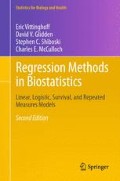Abstract
Post-menopausal women who exercise less tend to have lower bone mineral density (BMD), putting them at increased risk for fractures. But they also tend to be older, frailer, and heavier, which may explain the association between exercise and BMD. People whose diet is high fat on average have higher low-density lipoprotein (LDL) cholesterol, a risk factor for CHD. But they are also more likely to smoke and be overweight, factors which are also strongly associated with CHD risk. Increasing body mass index (BMI) predicts higher levels of hemoglobin HbA 1c , a marker for poor control of glucose levels; however, older age and ethnic background also predict higher HbA 1c .
Access this chapter
Tax calculation will be finalised at checkout
Purchases are for personal use only
References
Ananth, C. V. and Kleinbaum, D. G. (1997). Regression models for ordinal responses: a review of methods and applications. International Journal of Epidemiology, 26, 1323–1333.
Baron, R. M. and Kenny, D. A. (1986). The moderator-mediator variable distinction in social psychological research: conceptual, strategic, and statistical considerations. Journal of Personality and Social Psychology, 51(6), 1173–1182.
Belsey, D. A., Kuh, E. and Welsch, R. E. (1980). Regression Diagnostics. John Wiley & Sons, New York, Chichester.
Breiman, L. (2001). Statistical modeling: the two cultures. Statistical Science, 16(3), 199–231.
Brookes, S. T., Whitley, E., Peters, T. J., Mulheran, P. A., Egger, M. and Smith, G. D. (2001). Subgroup analyses in randomised controlled trials: quantifying the risks of false-positives and false-negatives. The National Coordinating Centre for Health Technology Assessment, University of Southampton, Southampton, UK.
Cleveland, W. S. (1985). The Elements of Graphing Data. Wadsworth & Brooks/Cole, Pacific Grove, CA.
Draper, N. R. and Smith, H. (1981). Applied Regression Analysis. John Wiley & Sons, New York, Chichester.
Freedman, L. S., Graubard, B. I. and Schatzkin, A. (1992). Statistical validation of intermediate endpoints for chronic diseases. Statistics in Medicine, 11, 167–178.
Gail, M. and Simon, R. (1985). Testing for qualitative interactions between treatment effects and patient subsets. Biometrics, 41, 361–372.
Greenland, S. (1989). Modeling and variable selection in epidemiologic analysis. American Journal of Public Health, 79(3), 340–349.
Greenland, S. (1994). Alternative models for ordinal logistic regression. Statistics in Medicine, 13, 1665–1677.
Hastie, T. J. and Tibshirani, R. J. (1986). Generalized additive models (with discussion). Statistical Science, 1, 297–318.
Hsieh, F. Y., Bloch, D. A. and Larsen, M. D. (1998). A simple method of sample size calculation for linear and logistic regression. Statistics in Medicine, 17, 541–557.
Hulley, S., Grady, D., Bush, T., Furberg, C., Herrington, D., Riggs, B. and Vittinghoff, E. (1998). Randomized trial of estrogen plus progestin for secondary prevention of heart disease in postmenopausal women. The Heart and Estrogen/progestin Replacement Study. Journal of the American Medical Association, 280(7), 605–613.
Li, Z., Meredith, M. P. and Hoseyni, M. S. (2001). A method to assess the proportion of treatment effect explained by a surrogate endpoint. Statistics in Medicine, 20, 3175–3188.
Long, J. S. and Ervin, L. H. (2000). Using heteroscedasticity consistent standard errors in the linear regression model. American Statistician, 54, 217 – 224.
MacKinnon, J. G. and White, H. (1985). Some heteroskedasticity consistent covariance matrix estimators with improved finite sample properties. Journal of Econometrics, 29, 53–57.
Molenberghs, G., Buyse, M., Geys, H., Renard, D., Burzykowski, T. and Alonso, A. (2002). Statistical challenges in evaluation of surrogate endpoints in randomized trials. Controlled Clinical Trials, 23, 607–625.
Petersen, M., Sinisi, S. and van der Laan, M. (2006). Estimation of direct causal effects. Epidemiology-Baltimore, 17(3), 276–284.
Robins, J. M. and Greenland, S. (1992). Identifiability and exchangeability for direct and indirect effects. Epidemiology, 3, 143–155.
Stone, C. J. (1986). Comment: Generalized additive models. Statistical Science, 47, 312–314.
VanderWeele, T. (2009). Marginal structural models for the estimation of direct and indirect effects. Epidemiology-Baltimore, 20(1), 18–26.
Vansteelandt, S. (2009). Estimating direct effects in cohort and case-control studies. Epidemiology, 20(6), 851–860.
Vuong, Q. H. (1989). Likelihood ratio tests for model selection and non-nested hypotheses. Econometrica, 57(2), 307–333.
Weisberg, S. (1985). Applied Linear Regression. John Wiley & Sons, New York, Chichester.
Huber, P. J. (1967). The behaviour of maximum likelihood estimates under nonstandard conditions. In: The Fifth Berkeley Symposium in Mathematical Statistics and Probability (edited by L. Le Cam and J. Neyman). University of California Press, Berkeley.
Snedecor, G. W. and Cochran, W. G. (1989). Statistical Methods. Iowa State University Press, Ames, IA, eighth ed.
Author information
Authors and Affiliations
Rights and permissions
Copyright information
© 2012 Springer Science+Business Media, LLC
About this chapter
Cite this chapter
Vittinghoff, E., Glidden, D.V., Shiboski, S.C., McCulloch, C.E. (2012). Linear Regression. In: Regression Methods in Biostatistics. Statistics for Biology and Health. Springer, Boston, MA. https://doi.org/10.1007/978-1-4614-1353-0_4
Download citation
DOI: https://doi.org/10.1007/978-1-4614-1353-0_4
Published:
Publisher Name: Springer, Boston, MA
Print ISBN: 978-1-4614-1352-3
Online ISBN: 978-1-4614-1353-0
eBook Packages: Mathematics and StatisticsMathematics and Statistics (R0)

